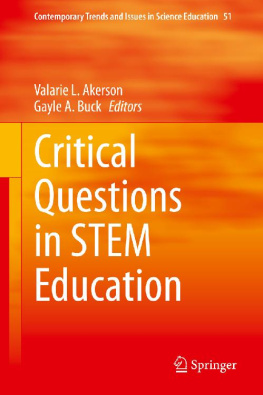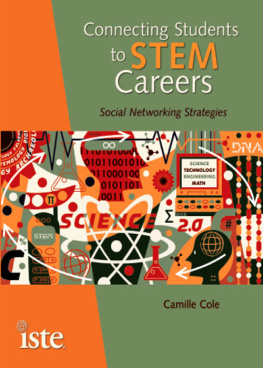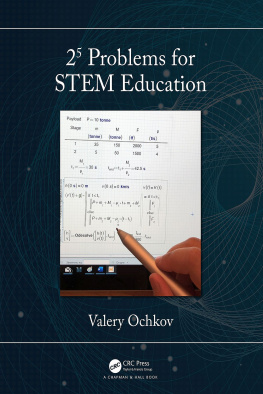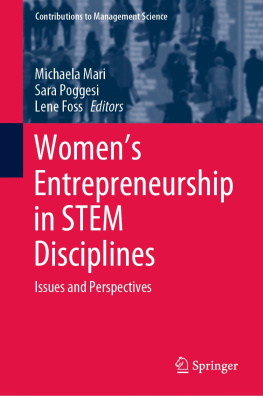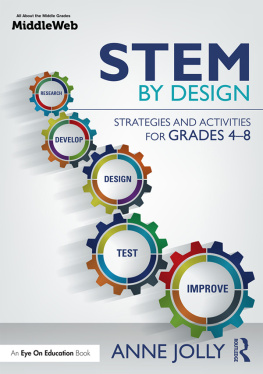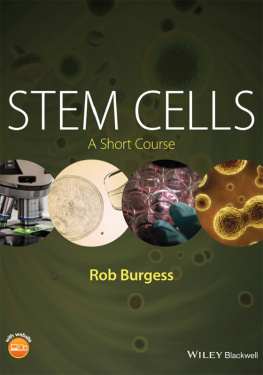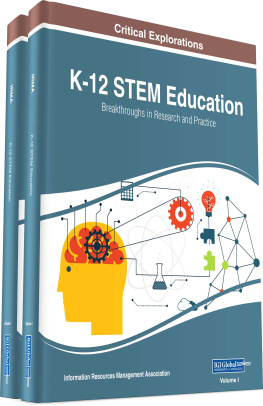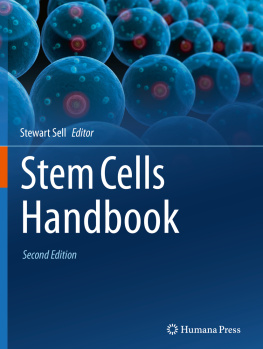Volume 51
Contemporary Trends and Issues in Science Education
Series Editor
Dana L. Zeidler
University of South Florida, Tampa, USA
Editorial Board
John Lawrence Bencze
University of Toronto, Toronto, ON, Canada
Michael P. Clough
Iowa State University, Ames, IA, USA
Fouad Abd-El-Khalick
University of North Carolina, Chapel Hill, NC, USA
Marissa Rollnick
University of the Witwatersrand, Johannesburg, South Africa
Troy D. Sadler
University of Missouri, Columbia, MO, USA
Svein Sjeberg
University of Oslo, Oslo, Norway
David Treagust
Curtin University of Technology, Perth, Australia
Larry D. Yore
University of Victoria, British Columbia, Canada
The book series Contemporary Trends and Issues in Science Education Claudia.Acuna@springer.com provides a forum for innovative trends and issues impacting science education. Scholarship that focuses on advancing new visions, understanding, and is at the forefront of the field is found in this series. Authoritative works based on empirical research and/or conceptual theory from disciplines including historical, philosophical, psychological and sociological traditions are represented here. Our goal is to advance the field of science education by testing and pushing the prevailing sociocultural norms about teaching, learning, research and policy. Book proposals for this series may be submitted to the Publishing Editor: Claudia Acuna E-mail:The book series Contemporary Trends and Issues in Science Education provides a forum for innovative trends and issues impacting science education. Scholarship that focuses on advancing new visions, understanding, and is at the forefront of the field is found in this series. Authoritative works based on empirical research and/or conceptual theory from disciplines including historical, philosophical, psychological and sociological traditions are represented here. Our goal is to advance the field of science education by testing and pushing the prevailing sociocultural norms about teaching, learning, research and policy. Book proposals for this series may be submitted to the Publishing Editor: Claudia Acuna E-mail: Claudia.Acuna@springer.com
More information about this series at http://www.springer.com/series/6512
Editors
Valarie L. Akerson and Gayle A. Buck
Critical Questions in STEM Education
1st ed. 2020
Editors
Valarie L. Akerson
Curriculum & Instruction, Indiana University, Bloomington, IN, USA
Gayle A. Buck
Curriculum & Instruction, Indiana University, Bloomington, IN, USA
ISSN 1878-0482 e-ISSN 1878-0784
Contemporary Trends and Issues in Science Education
ISBN 978-3-030-57645-5 e-ISBN 978-3-030-57646-2
https://doi.org/10.1007/978-3-030-57646-2
Springer Nature Switzerland AG 2020
This work is subject to copyright. All rights are reserved by the Publisher, whether the whole or part of the material is concerned, specifically the rights of translation, reprinting, reuse of illustrations, recitation, broadcasting, reproduction on microfilms or in any other physical way, and transmission or information storage and retrieval, electronic adaptation, computer software, or by similar or dissimilar methodology now known or hereafter developed.
The use of general descriptive names, registered names, trademarks, service marks, etc. in this publication does not imply, even in the absence of a specific statement, that such names are exempt from the relevant protective laws and regulations and therefore free for general use.
The publisher, the authors and the editors are safe to assume that the advice and information in this book are believed to be true and accurate at the date of publication. Neither the publisher nor the authors or the editors give a warranty, expressed or implied, with respect to the material contained herein or for any errors or omissions that may have been made. The publisher remains neutral with regard to jurisdictional claims in published maps and institutional affiliations.
This Springer imprint is published by the registered company Springer Nature Switzerland AG
The registered company address is: Gewerbestrasse 11, 6330 Cham, Switzerland
Foreword to Critical Questions in STEM Education
For those working in STEM education as teachers, principals, teacher educators, and researchers, a central concern in recent years is developing a consensus on what STEM education can and should be, in terms of curricular content, pedagogy, and application to real-world problems. Perhaps heightening a sense of urgency regarding this task is STEMs near-juggernaut quality as an educational movement internationally. Meanwhile, a rush by various discipline advocates to claim curricular terrain in K-12 STEM has led to calls for STEAM (adding art), STREAM (reading), CSTEM (coding or computer science), and so on, which complicates development of a clear understanding of what STEM education should include. STEM as ambiguous slogan (Bybee 2013) nonetheless has rapidly diffused across many mass education systems, proving to be an effective tool to advocate for resources (Shaughnessy 2012). The contributions in this volume offer several cornerstones, comprising the parts of the book, from which to examine questions about the contours of STEM in a thoughtful and research-informed manner. The point of departure here is a working definition of STEM that includes a renewed focus on the variation across individual disciplines as well as the meaningful interdependence that connects disciplines constituting STEM.
Since the early days of STEM being promoted as a kind of curricular package, a frequent element of the sloganeering blithely portrayed STEM education as integrated and interdisciplinary, even as curriculum scholars have emphasized the tremendous difficulty for interdisciplinary knowledge to secure a place in the school curriculum. STEM education scholars could benefit from prior work on the challenges of developing and implementing interdisciplinary curricula, however appealing their ring, such as in social studies and humanities (Ravitch 2003; Wineburg & Grossman 2000). In this volume, we find a serious attempt to conceptualize the limits of the interdisciplinarity of STEM, starting in the first part with a series of chapters articulating the nature of each of the four areas (extending Ledermans groundbreaking work on the nature of science) and their varied epistemological and ontological underpinnings. In an overview of this first part, Akerson and colleagues boldly suggest that given the substantial differences in the core natures of the disciplines (and even within each area), there can be no analogous and fully coherent nature of STEM. If these scholars are right, the implicit question emerges regarding how truly integrated and interdisciplinary STEM can be.
This tension is illustrated in Part 2, which views STEM education from the ground up, considering approaches to teaching STEM, both at the level of the classroom and the school, but also the challenges in preparing teachers to support integrated STEM learning. The self-study by Yin (Chap. ) offer an organizational form that affords opportunities and time to both integrate and apply STEM knowledge, but even there, students are encouraged to choose areas of particular interest to focus on during group projects (e.g., Do the part you are interested in), effectively de-integrating the STEM work to some extent.
The final part raises broader questions about perceptions of STEM by various stakeholders. Perhaps, in a sense, school-based STEM is what school STEM does. Newman and colleagues (Chap. ) ground coding decisions about what is and what isnt a STEM major based on whether the major was located in the institutions College of Natural Sciences and Mathematics, which raises questions of how new or rapidly changing fields (like psychology) are classified with respect to the STEM umbrella. In the end, there are numerous echoes of the doubts raised in Part 1 about whether there can be a coherent nature of STEM.

